Analysis Regarding the Implementation of the Circular Economy in Romania
Abstract
1. Introduction
- the systematic valorized of waste and by-products;
- the minimization of loss caused by dispersion;
- the dematerialized of economy;
- the reduction of energy in base of fossil hydrocarbon.
- waste equals food (eliminate the concept of waste);
- use renewable energies;
- support (celebrate) diversity.
- nature as model (nature can provide models and solutions in order to solve human problems);
- nature as measure (nature can be viewed as a standard to judge the sustainability of our innovation);
- nature as mentor (nature can be viewed as a source of knowledge for our innovation).
2. Research Methodology
2.1. Production and Consumption Area
- Generation of municipal waste per capita—expressed in Kg per capita—it indicates the quantity of waste collected from the territory of a municipality and managed through the waste management system. Waste produced by residents, commerce, offices, and public institutions is included here. This category does not include industrial waste and waste resulting from agricultural activity. Figure 2 exemplifies the per capita distribution of municipal waste in EU countries.
- Generation of waste excluding major mineral waste per GDP unit—it evaluates the quantity of waste collected in a country (expressed in mass unit), per GDP unit (expressed in Euro) excluding major mineral waste. The measure unit of the indicator is Kg per thousand Euros. The calculus of this indicator includes all types of waste (from economic/industrial sectors and from households) but excludes the major mineral waste as that resulting from construction/demolition or mining activities. Being related to the gross domestic product, it makes a connection between economic development and the amount of waste generated. The desired decoupling of economic growth from the resulting volume of waste requires high-performance technologies, intelligent design, creativity.
- Generation of waste excluding major mineral waste per domestic material consumption—it reports all waste generated in a country (in mass unit), excluding major mineral waste, to the domestic material consumption (DMC) of a country. It is expressed in percentage (%) as both factors are measured in tons. The indicator reflects the efficiency of the use of raw materials.
2.2. Waste Management
- Recycling rates (the share of waste which is recycled);
- Recycling rates for specific waste streams (packaging waste, biowaste, e-waste, etc.
- The first of these two indicators is in turn subdivided into Recycling rate of municipal waste and Recycling rate of all waste excluding major mineral waste.
2.3. Secondary Raw Materials
2.4. Competitivness and Innovation
- Gross investment in tangible goods related to circular economy sectors, which cumulates the private investments in tangible goods made during a year and whose lifetime exceeds that year. Investments in the repair, reuse and recycle sector, even rentals, including land acquisition, if applicable, are included here. It is expressed as a percentage from the gross domestic product;
- Number of persons employed in the circular economy sectors, which is also expressed as a percentage of the total employment achieved in a year, highlighting the number of jobs created through the transition to a circular economy in which repair, recycling and selection activities, together with waste recovery are becoming more and more important;
- Gross value added at factor cost in the circular economy sectors is calculated in millions of euro and then, in relation to the gross domestic product, the contribution of the sectors specific to the circular economy to the economy of the respective country is obtained in percentages.
3. Results: The Implementation of the Circular Economy in Romania
3.1. Self-Sufficiency of Raw Materials for Production in the EU
3.2. Green Public Procurement (GPP)
3.3. Waste Generation
- first of all, there is a clear link between the standard of living, the GDP of a country, the amount of goods circulating in the economy and implicitly, the amount of waste generated;
- the income level was not reflected in the same way in the amount of waste generated, as the differences among countries depend on several factors: the way municipalities collect waste, the appearance on the market of more sustainable products, the increase in the population’s level of information regarding waste management, discipline and changes in its behavior;
- in the 2015–2019 period (we exclude the year 2020 from the calculation due to the extreme situation brought about by the pandemic, with a significant impact on the GDP), the amount of municipal waste increased by 4.3%, while the GDP at the EU 27 level, increased by approximately 8.1%; it can be said that steps have been taken in decoupling economic growth from the amount of waste generated, according to the principles of the circular economy and in accordance with Article 30 of the revised Waste Framework Directive;
- the next indicator from the Production and consumption group, Generation of waste excluding major mineral wastes per GDP, “reflects the waste intensity of the economy and provides a measure of ‘eco-efficiency” [52];
- according to Table 4, for this indicator, Romania is far above the European average and the situation is similar in the case of all emerging countries whose GDP per capita is low. Poland, to take the previous example, has values between 184 in 2010 and 169 kg per thousand euro in 2018 [53], while having a higher GDP than Romania. At the same time, the indicator has decreasing values for Romania, which indicates a favorable economic evolution and a certain control over the amount of waste generated. According to the 2018 data, Romania ranks 24th, followed by Poland, Bulgaria and Estonia. From our point of view, this indicator that reports the amount of waste to the GDP is not relevant from the EC’s point of view.
3.4. Waste Management
- the Landfill Directive—Directive (EU) 2018/850) was adopted through Ordinance no. 2/2021-08-11;
- the Waste Framework Directive—Directive (EU) 2018/851 was transposed through the Government Emergency Ordinance of 19 August 2021, GEO 92/2021;
- the Packaging and Packaging Waste Directive—Directive (EU) 2018/852 is the subject of the Government Ordinance of 11 August 2021, GO no. 1/11.08.2021.
- plastic packaging waste;
- paper and cardboard packaging;
- packaging made of wood;
- metal packaging of different types;
- glass packaging.
3.5. Secondary Raw Materials
3.6. Competitivness and Innovation
4. Discussion
- It achieves a percentage below the European average (81.8% of the EU average) but quite good compared to other states, in the recovery and recycling of wooden packaging, occupying position 14 at the European level.
- It is far behind compared to European countries in the recycling of metal and glass packaging waste. With a percentage of 70.8% of the EU average, it ranks 25th for metal packaging and 20th for glass packaging, recycling only 80.6% of the EU average, whereas there are states that recycle 100% of the glass packaging and the EU recycles 75.8% of the collected glass packaging on average.
- Complete transposition of European directives into the national legislation;
- Better performances in terms of the selective collection of municipal waste and biowaste through the extension of a greater number of collection points;
- Development of the necessary infrastructure and standards regarding food waste composting and recovery, more applied educational campaigns with greater impact among the population, application of penalties for accidental or improper waste storage;
- Uniform distribution throughout the country of recycling facilities for different types of waste: plastic packaging, glass, etc., and especially for waste resulting from construction and demolition;
- Updated methodologies and digital tracking of waste flows;
- A policy to encourage commercial companies operating in the circular economy field through lower taxation, lower tax for workers in these fields, etc.
- Creation of a digital waste platform for its recovery, including that containing scarce raw materials;
- An adequate functioning market for waste and recycled raw materials.
- Establishing research grants dedicated to the fields of environmental protection and the circular bioeconomy;
- Introducing study programs dedicated to the circular economy in the offer of universities and the creation of skills in the field.
Author Contributions
Funding
Institutional Review Board Statement
Informed Consent Statement
Data Availability Statement
Acknowledgments
Conflicts of Interest
References
- Lacy, P.; Rutqvist, J. The Roots of the Circular Economy. In Waste to Wealth; Palgrave Macmillan: London, UK, 2015; pp. 19–23. [Google Scholar]
- Ellen MacArthur Foundation. What Is a Circular Economy? Available online: www.ellenmacarthurfoundation.org/circular-economy/concept/schools-of-thought (accessed on 29 August 2022).
- Erkman, S. Industrial ecology: An historical view. J. Clean. Prod. 1997, 5, 1–10. [Google Scholar] [CrossRef]
- ADEME. Methodological Guide to the Development of Regional Circular Economy Strategies in France. French Environment & Energy Management Agency. Available online: https://www.ademe.fr (accessed on 1 September 2022).
- Erkman, S. Industrial ecology: A new perspective on the future of the industrial system. Swiss Med. Wkly. 2001, 131, 531–538. [Google Scholar] [CrossRef] [PubMed]
- Stahel, W. The Performance Economy: Business Models for the Functional Service Economy. In Handbook of Performability Engineering; Palgrave Macmillan: New York, NY, USA, 2010; pp. 127–138. [Google Scholar]
- Mcgregor, S.L.T. Transdisciplinarity and Biomimicry. Transdiscipl. J. Eng. Sci. 2013, 4, 57–65. [Google Scholar] [CrossRef]
- Kirchherr, J.; Reike, D.; Hekkert, M. Conceptualizing the circular economy: An analysis of 114 definitions. Resour. Conserv. Recycl. 2017, 127, 221–232. [Google Scholar] [CrossRef]
- Winans, K.; Kendall, A.; Deng, H. The history and current applications of the circular economy concept. Renew. Sustain. Energy Rev. 2017, 68, 825–833. [Google Scholar] [CrossRef]
- Lah, O. Circular Economy Policies and Strategies of Germany. In Towards a Circular Economy: Corporate Management and Policy Pathways; Project Report 2014-44; Anbumozhi, V., Kim, J., Eds.; ERIA Research: Jakarta, Indonesia, 2016; pp. 59–74. [Google Scholar]
- Andrade, C.; Selosse, S.; Maïzi, N. Thirty years since the circular economy concept emerged: Has it reached a consensus. In Working Paper; Mines ParisTech, Université PSL, Centre de Mathématiques Appliquées, Sophia Antipolis: Valbonn, France, 2021; p. 27. [Google Scholar]
- European Commission. Communication No. 398, 2014. Towards a Circular Economy: A Zero Waste Programme for Europe; (COM No. 398, 2014); Commission of European Communities: Brussels, Belgium, 2014; Available online: https://ec.europa.eu/environment/circulareconomy/pdf/circular-economy-communication.pdf (accessed on 14 June 2022).
- European Commission. Closing the Loop—An EU Action Plan for the Circular Economy COM/2015/0614 Final. Available online: https://www.eea.europa.eu/policy-documents/com-2015-0614-final (accessed on 14 June 2022).
- European Commission. Measuring Progress towards Circular Economy in the European Union—Key Indicators for a Monitoring Framework. Available online: https://eur-lex.europa.eu/legal-content/EN/TXT/PDF/?uri=CELEX:52018SC0017&from=EN (accessed on 14 June 2022).
- European Commission. Critical Raw Materials Resilience: Charting a Path towards Greater Security and Sustainability, COM(2020) 474 Final. Available online: https://eur-lex.europa.eu/legal-content/EN/TXT/?uri=CELEX%3A52020DC0474 (accessed on 14 June 2022).
- Girtan, M.; Wittenberg, A.; Grilli, M.L.; De Oliveira, D.P.S.; Giosuè, C.; Ruello, M.L. The Critical Raw Materials Issue between Scarcity, Supply Risk, and Unique Properties. Materials 2021, 14, 1826. [Google Scholar] [CrossRef] [PubMed]
- European Commission. Green Public Procurement. Available online: https://ec.europa.eu/environment/gpp/what_en.htm (accessed on 14 June 2022).
- Blome, C.; Hollos, D.; Paulraj, A. Green procurement and green supplier development: Antecedents and effects on supplier performance. Int. J. Prod. Res. 2014, 52, 32–49. [Google Scholar] [CrossRef]
- Slastanova, N.; Palus, H.; Sulek, R.; Parobek, J.; Slastanova, K. The Benefits of Applying the Green Purchasing. In Proceedings of the 20th International Scientific Conference Globalization and its Socio-Economic Consequences 2020, SHS Web of Conference, Zilina, Slovakia, 21–22 October 2021; Volume 92. [Google Scholar] [CrossRef]
- Bocken, N.M.P.; De Pauw, I.; Van der Grinten, C.B. Product design and business model strategies for a circular economy. J. Ind. Prod. Eng. 2016, 33, 308–320. [Google Scholar] [CrossRef]
- Environmental European Bureau. Unpacking the Circular Economy Package. Available online: https://eeb.org/library/unpacking-the-circular-economy-package (accessed on 14 June 2022).
- Silpa, K.; Yao, L.C.; Bhada-Tata, P.; Van Woerden, F. What a Waste 2.0: A Global Snapshot of Solid Waste Management to 2050; Urban Development Series; World Bank: Washington, DC, USA, 2018; Available online: https://openknowledge.worldbank.org/handle/10986/30317 (accessed on 14 June 2022).
- Eurostat. Statistics Explained, Municipal Waste Statistic. Available online: https://ec.europa.eu/eurostat/statistics-explained/index.php?title=Municipal_waste_statistics#Municipal_waste_generation (accessed on 14 June 2022).
- European Commission. Commission of European Communities. Communication No. 98, 2020. A New Circular Economy Action Plan for a Cleaner and More Competitive Europe; COM No. 98; European Commission: Brussels, Belgium, 2020. [Google Scholar]
- Smol, M.; Duda, J.; Czaplicka-Kotas, A.; Szołdrowska, D. Transformation towards Circular Economy (CE) in Municipal Waste Management System: Model Solutions for Poland. Sustainability 2020, 12, 4561. [Google Scholar] [CrossRef]
- Directive (EU) 2018/851 of the European Parliament and of the Council of 30 May 2018 amending Directive 2008/98/EC on Waste. Available online: http://data.europa.eu/eli/dir/2018/851/oj (accessed on 14 June 2022).
- FAO; IFAD; UNICEF; WFP; WHO. The State of Food Security and Nutrition in the World. Transforming Food Systems for Food Security, Improved Nutrition and Affordable Healthy Diets for All; FAO: Rome, Italy, 2021. [Google Scholar]
- Food and Agriculture Organization of the United Nations. Sustainable Development Goals. Available online: https://www.fao.org/sustainable-development-goals/indicators/1231/en (accessed on 16 June 2022).
- Teigiserova, D.A.; Hamelin, L.; Thomsen, M. Towards transparent valorization of food surplus, waste and loss: Clarifying definitions, food waste hierarchy, and role in the circular economy. Sci. Total Environ. 2020, 706, 140396. [Google Scholar] [CrossRef]
- Statista. Annual Household Food Waste Produced per Capita in Selected Countries in Europe as of 2020. Available online: https://www.statista.com/statistics/1219830/per-capita-food-waste-of-selected-countries-in-europe/ (accessed on 16 June 2022).
- EUR-lex. Decision 2011/753—2011/753/EU: Commission Decision of 18 November 2011 Establishing Rules and Calculation Methods for Verifying Compliance with the Targets Set in Article 11(2) of Directive 2008/98/EC (Notified under Document C(2011) 8165). Available online: https://www.eumonitor.eu/9353000/1/j9vvik7m1c3gyxp/viv26bka78zv (accessed on 16 June 2022).
- European Environment Agency. Mineral Waste from Construction and Demolition, Waste Treatment. Available online: https://www.eea.europa.eu/data-and-maps/daviz/mineral-waste-from-construction-and#tab-googlechartidchart13 (accessed on 16 June 2022).
- Eurostat. Waste Management Indicators. Available online: https://ec.europa.eu/eurostat/statistics-explained/index.php?title=Waste_management_indicators&oldid=548999 (accessed on 16 June 2022).
- Eurostat. Reaching 2030’s Residual Municipal Waste Target—Why Recycling Is Not Enough. Available online: https://www.eea.europa.eu/publications/reaching-2030s-residual-municipal-waste (accessed on 16 June 2022).
- EUR-lex. Directive (EU) 2018/851 of the European Parliament and of the Council of 30 May 2018 amending Directive 2008/98/EC on Waste (Text with EEA Relevance). Available online: https://eur-lex.europa.eu/legal-content/EN/TXT/?uri=celex%3A32018L0851 (accessed on 16 June 2022).
- European Commission. European Parliament and Council Directive 94/62/EC of 20 December 1994 on Packaging and Packaging Waste. Available online: https://eur-lex.europa.eu/legal-content/EN/TXT/?uri=celex%3A31994L0062 (accessed on 16 June 2022).
- EUR-lex. Directive 2012/19/EU of the European Parliament and of the Council of 4 July 2012 on Waste Electrical and Electronic Equipment (WEEE) (Recast) Text with EEA Relevance. Available online: https://eur-lex.europa.eu/legal-content/EN/TXT/?uri=celex%3A32012L0019 (accessed on 16 June 2022).
- European Environment Agency. Bio-Waste in Europe—Turning Challenges into Opportunities. Available online: https://www.eea.europa.eu/publications/bio-waste-in-europe (accessed on 16 June 2022).
- Eurostat. Contribution of Recycled Materials to Raw Materials Demand—End-of-Life Recycling Input Rates (EOL-RIR). Available online: https://ec.europa.eu/eurostat/databrowser/view/cei_srm010/default/table?lang=en (accessed on 16 June 2022).
- Eurostat. Trade in Recyclable Raw Materials. Available online: https://ec.europa.eu/eurostat/databrowser/view/cei_srm020/default/table?lang=en (accessed on 16 June 2022).
- Smol, M.; Marcinek, P.; Duda, J.; Szołdrowska, D. Importance of Sustainable Mineral Resource Management in Implementing the Circular Economy (CE) Model and the European Green Deal Strategy. Resources 2020, 9, 55. [Google Scholar] [CrossRef]
- Eurostat. Patents Related to Recycling and Secondary Raw Materials. Available online: https://ec.europa.eu/eurostat/databrowser/view/cei_cie020/default/table?lang=en (accessed on 16 June 2022).
- European Commission. Communication from the Commission to the European Parliament, the Council, the European Economic and Social Committee and the Committee of the Regions Critical Raw Materials Resilience: Charting a Path towards Greater Security and Sustainability. Available online: https://ec.europa.eu/docsroom/documents/42849/attachments/2/translations/en/renditions/native (accessed on 16 June 2022).
- Jurnalul.ro. The Hidden Treasure of Romania—The Strategic Materials. Available online: https://jurnalul.ro/bani-afaceri/economia/comoara-ascunsa-a-romaniei-materialele-strategice-869293.html (accessed on 16 June 2022).
- Giucristglobal. The Riches from the Underground of Romania and the Republic of Moldova. Available online: https://giucristglobal.ro/bogatiile-din-subsolul-romaniei-si-al-republicii-moldova/ (accessed on 16 June 2022).
- Gov.ro. Available online: http://www.economie.gov.ro/images/resurseinerale/Prezentare%20GAVRIL%20BAICAN%2016%20oct%202018.pdf (accessed on 16 June 2022).
- Annastasiu, N. Mineral Resources—A Forgotten Potential! Available online: https://www.researchgate.net/publication/280947245_Resursele_minerale_-_un_potential_uitat (accessed on 16 June 2022).
- Ministry of the Environment. The Green Public Procurement Guide, which Contains the Minimum Environmental Protection Requirements for Certain Groups of Products and Services that Are Required in the Specifications; Official Monitor; Ministry of the Environment: Bucharest, Romania, 2018; Part I, No. 954.
- Romanian Parliament. Law No. 69/2016 regarding Green Public Procurement. Available online: https://lege5.ro/Gratuit/geydmmzygmzq/legea-nr-69-2016-privind-achizitiile-publiceverzi (accessed on 16 June 2022).
- ARDLD-Asociatia Română pentru Dezvoltare Locală Durabilă. First National Study on the Use of Green Public Procurement in Romania. Available online: https://www.onvlaw.ro/the-1st-national-study-on-green-public-procurement-in-romania-2 (accessed on 16 June 2022).
- Ciumara, T.; Lupu, I. Green Procurement Practices in Romania: Evidence from a Survey at the Level of Local Authorities. Sustainability 2020, 12, 10169. [Google Scholar] [CrossRef]
- Eurostat. Statistical Indicator, in Generation of Waste excluding Major Mineral Wastes per GDP Unit (cei_pc032). Available online: ec.europa.eu/eurostat/cache/metadata/en/cei_pc032_esmsip2.htm#meta_update1658230385456 (accessed on 16 June 2022).
- Eurostat. Generation of Waste excluding Major Mineral Wastes per GDP Unit. Available online: https://ec.europa.eu/eurostat/databrowser/view/cei_pc032/default/table?lang=en (accessed on 16 June 2022).
- UNEP. UNEP Food Waste Index Report 2021. Available online: https://www.unep.org/resources/report/unep-food-waste-index-report-2021 (accessed on 16 June 2022).
- Consiliul Economic și Social. LAW for the Amendment and Completion of Law No. 217/2016 on reducing Food Waste. Available online: https://www.ces.ro/newlib/PDF/proiecte/2022/b334.pdf (accessed on 16 June 2022).
- European Commission. Food Waste. Available online: https://food.ec.europa.eu/safety/food-waste_en (accessed on 16 June 2022).
- Guvernul României. Ordinance No. 1/2021 for the Amendment and Completion of Law No. 249/2015 Regarding the Management of Packaging and Packaging Waste. Available online: https://lege5.ro/Gratuit/ha3tonrsgaya/ordonanta-nr-1-2021-pentru-modificarea-si-completarea-legii-nr-249-2015-privind-modalitatea-de-gestionare-a-ambalajelor-si-a-deseurilor-de-ambalaje (accessed on 16 June 2022).
- European Parliament. E-Waste in the EU: Facts and Figures (Infographic). Available online: https://www.europarl.europa.eu/news/ro/headlines/society/20201208STO93325/deseurile-electronice-in-ue-date-si-cifre-infografic (accessed on 16 June 2022).
- Institutul European din România. The Transition to a Circular Economy. From Waste Management to a Green Economy in Romania. Available online: http://ier.gov.ro/wp-content/uploads/2019/03/Final_Studiul-3_Spos-2018_Economie-circular%C4%83-1.pdf (accessed on 16 June 2022).
- Dobre-Baron, O.; Nițescu, A.; Niță, D.; Mitran, C. Romania’s Perspectives on the Transition to the Circular Economy in an EU Context. Sustainability 2022, 14, 5324. [Google Scholar] [CrossRef]
- Ministerul Investitiilor si Proiectelor Europene. Proposal for the Council’s Implementing Decision Approving the Evaluation of Romania’s Recovery and Resilience Plan. Available online: https://mfe.gov.ro/wp-content/uploads/2021/09/e6f28710212d5a2d963ba440ce587a99.pdf (accessed on 16 June 2022).
- Guvernul României. Ordinance No. 6/2021 on Reducing the Impact of Certain Plastic Products on the Environment. Available online: http://www.ecoteca.ro/wp-content/uploads/2022/01/6_O_2021_12ian2022.pdf (accessed on 16 June 2022).
- Eurostat. Recycling Rate of Packaging Waste by Type of Packaging. Available online: https://ec.europa.eu/eurostat/databrowser/view/cei_wm020/default/table?lang=en (accessed on 16 June 2022).
- Ziarul Financiar. Romania on the Recycling Map. How Do We Close the Loop? Available online: https://www.zf.ro/supliment-zf-green-economy/romania-pe-harta-reciclarii-cum-inchidem-circuitul-20042698 (accessed on 16 June 2022).
- Eurostat. Available online: http://appsso.eurostat.ec.europa.eu/nui/show.do?dataset=env_ac_curm&lang=en (accessed on 16 June 2022).
- Eurostat. Private Investments, Jobs and Gross Value Added Related to Circular Economy Sectors. Available online: https://ec.europa.eu/eurostat/databrowser/view/cei_cie010/default/table?lang=en (accessed on 16 June 2022).
- Eurostat. GDP per Capita, Consumption per Capita and Price Level Indices. Available online: https://ec.europa.eu/eurostat/statistics-explained/index.php?title=GDP_per_capita,_consumption_per_capita_and_price_level_indices (accessed on 16 June 2022).
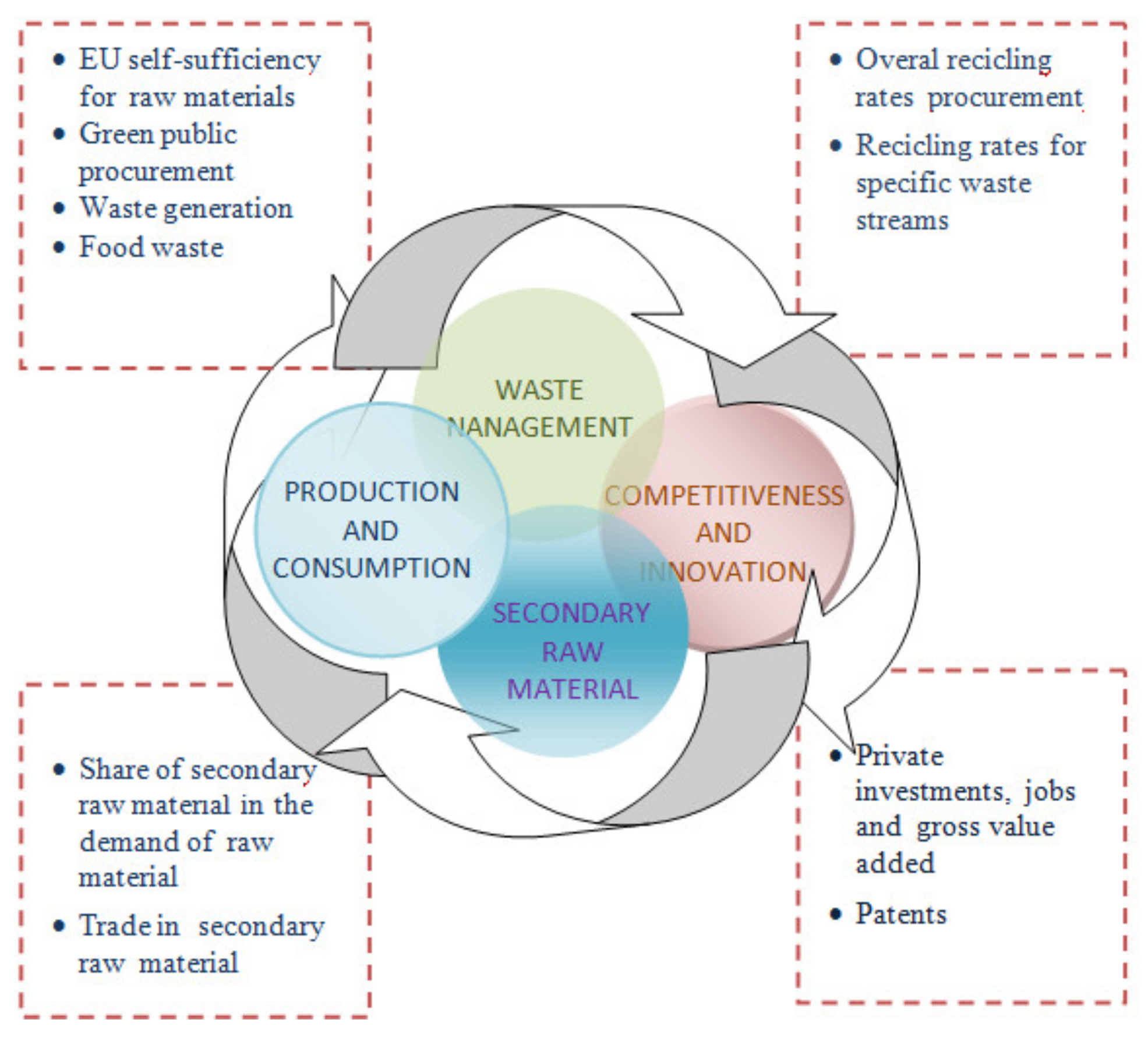
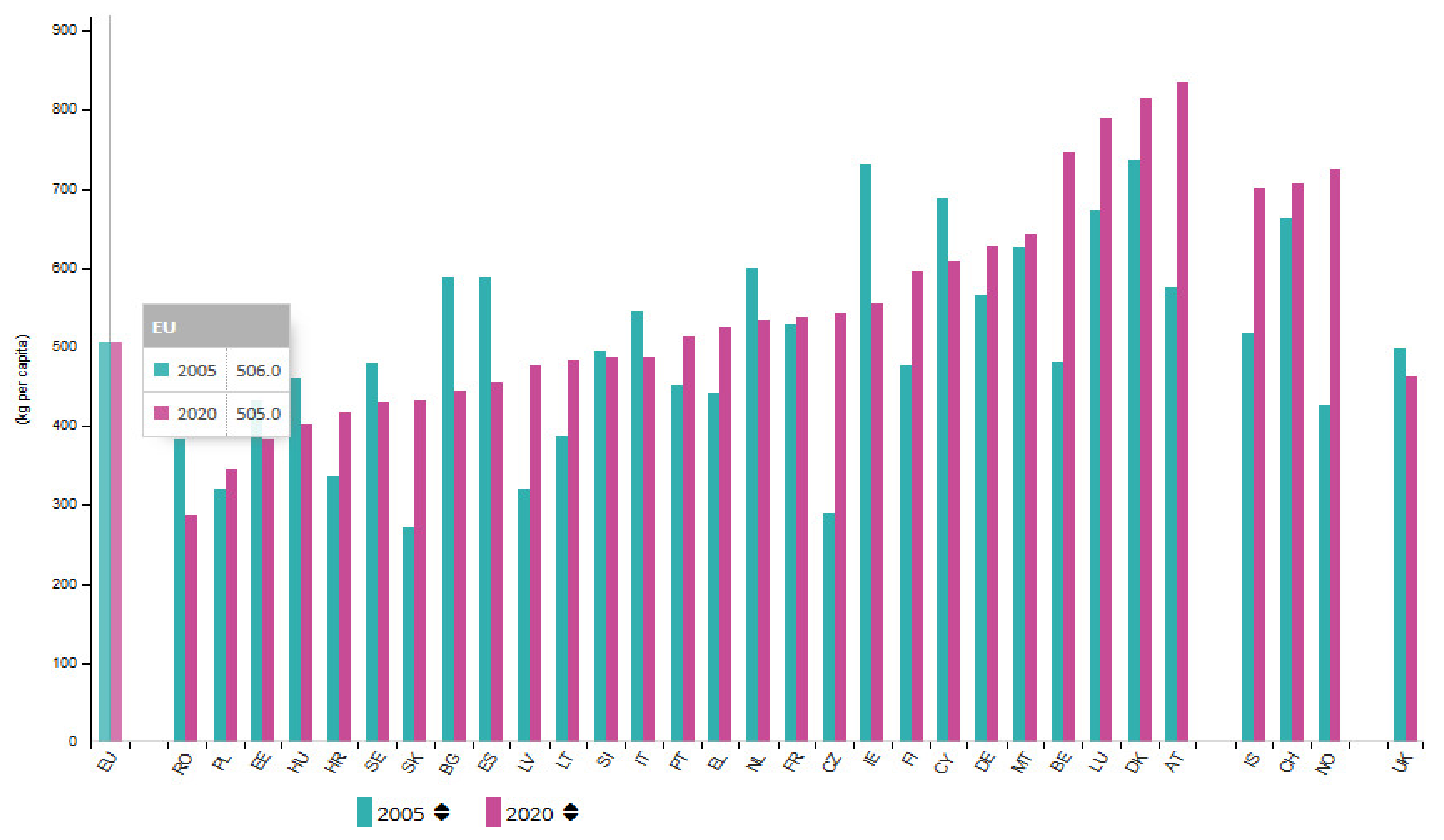
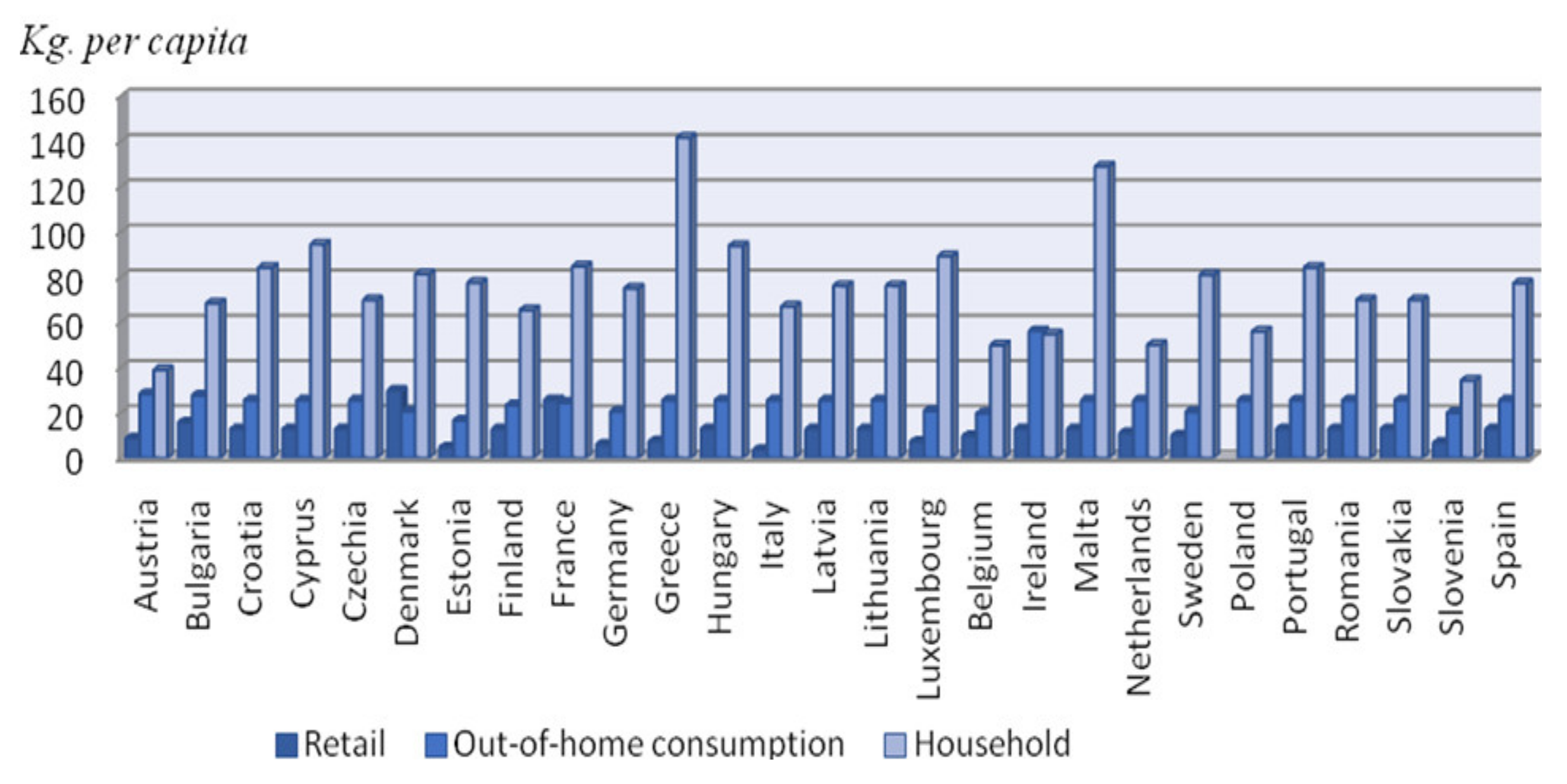

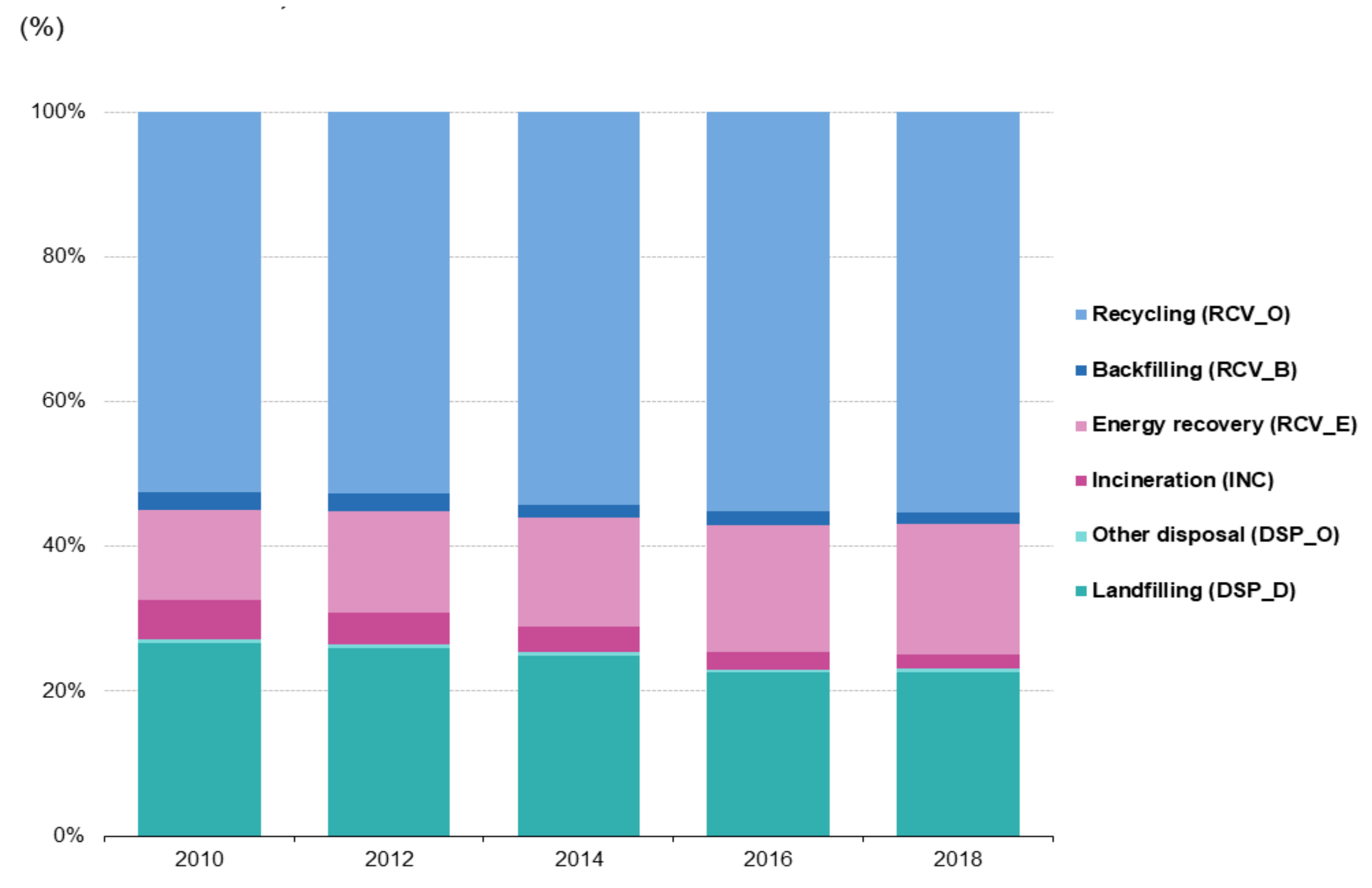
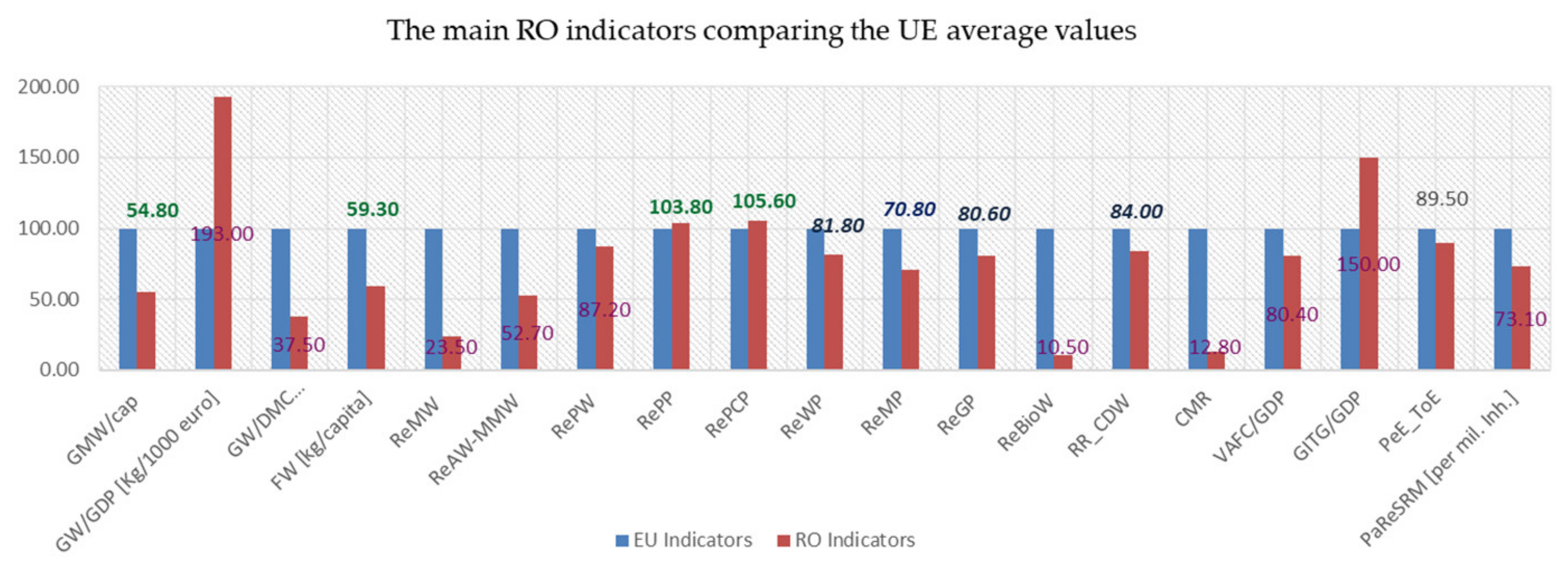
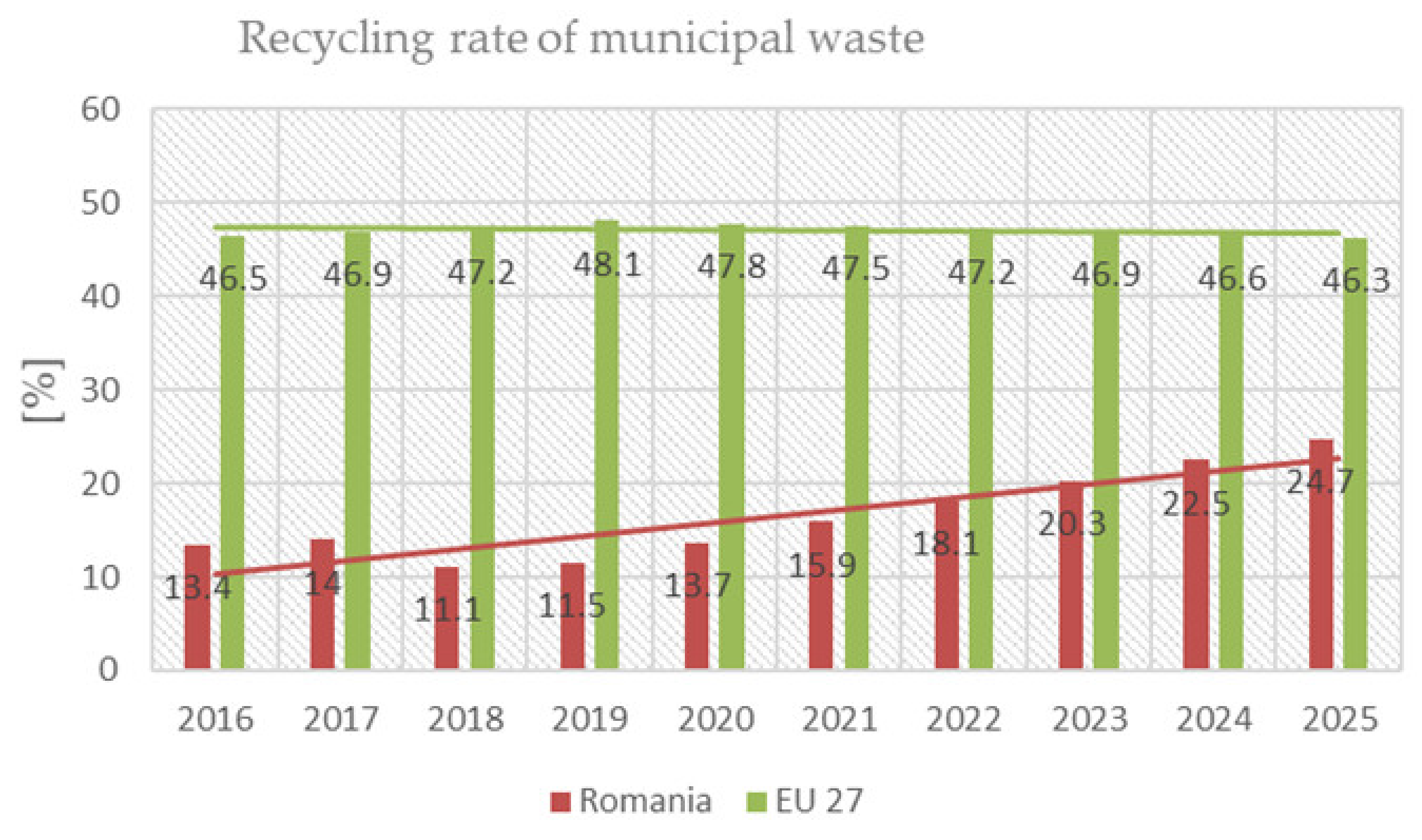
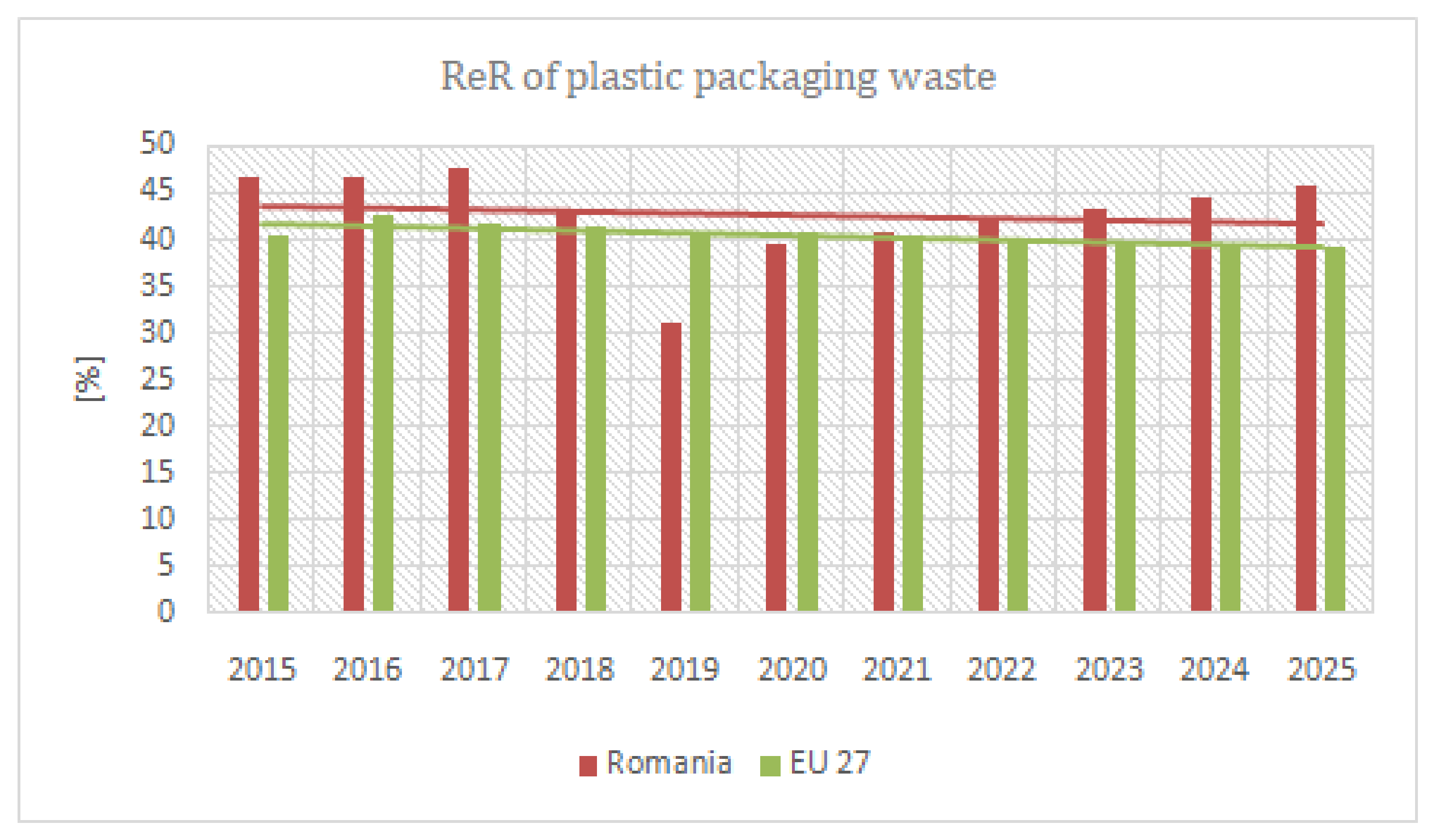

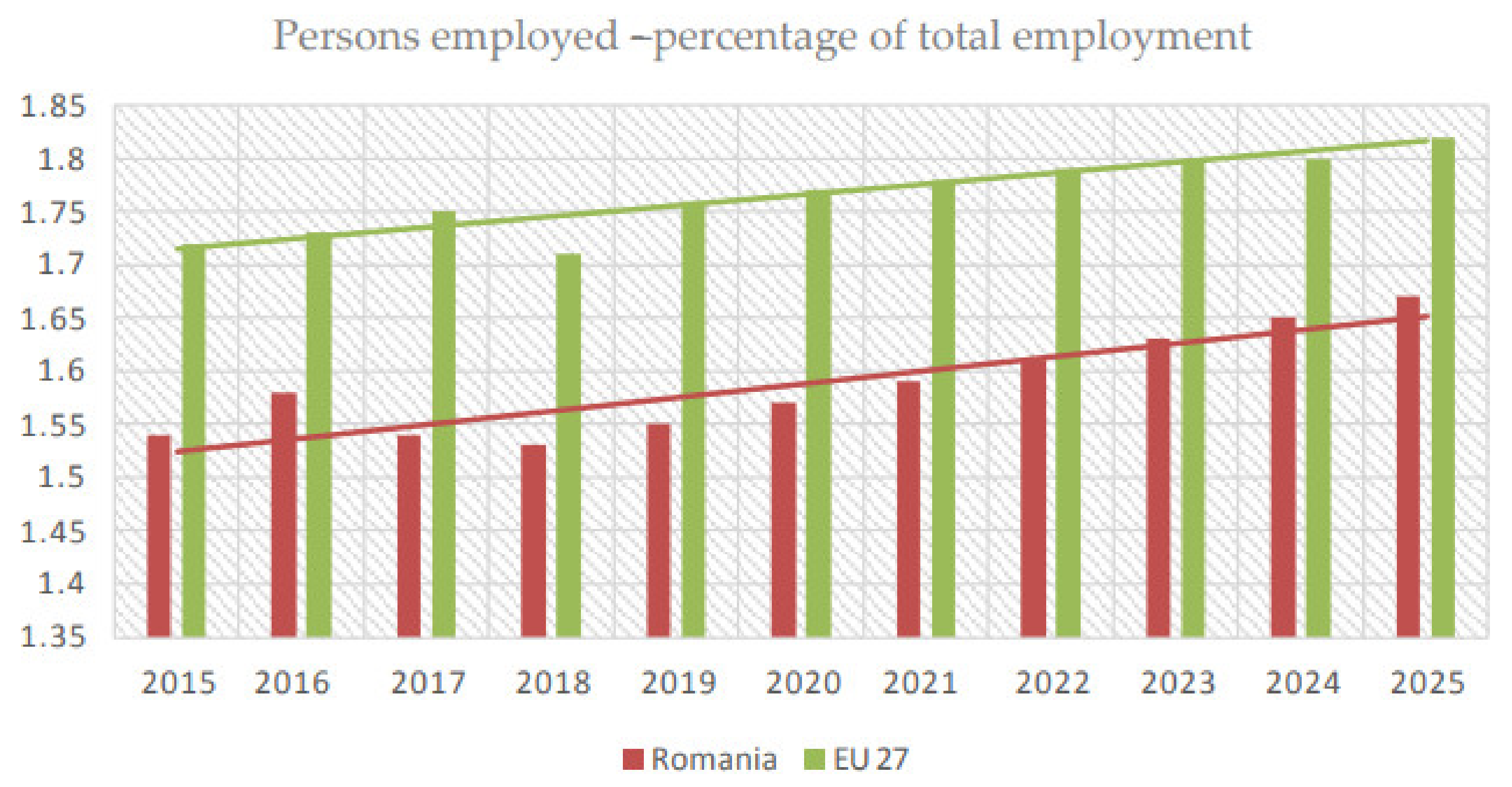
| Antimony | Hafnium | Phosphorus |
| Baryte | Heavy Rare Earth Elements | Scandium |
| Beryllium | Light Rare Earth Elements | Silicon metal |
| Bismuth | Indium | Tantalum |
| Borate | Magnesium | Tungsten |
| Cobalt | Natural Graphite | Vanadium |
| CokingCoal | Natural Rubber | Bauxite |
| Fluorspar | Niobium | Lithium |
| Gallium | Platinum Group Metals | Titanium |
| Germanium | Phosphaterock | Strontium |
| 2015 | 2016 | 2017 | 2018 | 2019 | 2020 | |
|---|---|---|---|---|---|---|
| Romania | 247 | 261 | 272 | 272 | 280 | 287 |
| EU 27 | 480 | 490 | 496 | 496 | 501 * | 505 |
| Austria | 560 | 564 | 570 | 579 | 588 | 834 |
| Denmark | 822 | 830 | 820 | 814 | 844 | 814 |
| Luxembourg | 607 | 815 | 798 | 803 | 791 * | 790 |
| Poland | 286 * | 307 * | 315 * | 329 | 336 | 346 |
| 2015 | 2016 | 2017 | 2018 | 2019 | 2020 | |
|---|---|---|---|---|---|---|
| Romania | 7290 | 7670 | 8280 | 8700 | 9120 | 8820 |
| EU 27 | 25,950 | 26,410 | 27,110 | 27,610 | 28,050 | 26,380 |
| Austria | 361,401 | 36,390 | 36,390 | 37,720 | 38,110 | 35,390 |
| Denmark | 45,630 | 46,720 | 47,740 | 48,450 | 48,970 | 47,890 |
| Luxembourg | 82,820 | 84,750 | 84,020 | 84,040 | 85,030 | 82,250 |
| Poland | 10,890 | 11,240 | 11,790 | 12,420 | 13,020 | 12,750 |
| 2010 | 2012 | 2014 | 2016 | 2018 | |
|---|---|---|---|---|---|
| Romania | 188 | 179 | 149 | 141 | 128 |
| EU 27 | 68 | 69 | 66 | 67 | 66 |
| 2010 | 2012 | 2014 | 2016 | 2018 | |
|---|---|---|---|---|---|
| Romania * | 8.6 | 6.5 | 5.6 | 4.7 | 4.8 |
| EU 27 | 12 | 12.4 | 12.7 | 13 | 12.8 |
| Recycling Rate of Municipal Waste (%) | 2016 | 2017 | 2018 | 2019 | 2020 |
| Romania | 13.4 | 14.0 | 11.1 | 11.5 | 13.7 |
| EU 27 | 46.5 | 46.9 | 47.2 | 48.1 * | 47.8 * |
| Recycling rate of all waste exclud. major mineral waste (%) | 2010 | 2012 | 2014 | 2016 | 2018 |
| Romania | 26 | 28 | 27 | 30 | 29 |
| EU 27 | 53 | 53 | 54 | - | 55 |
| Recycling rate of packaging waste by type of packaging (%) | 2015 | 2016 | 2017 | 2018 | 2019 |
| Romania | 55.9 | 60.4 | 60.4 | 57.9 | 44.6 |
| EU 27 | 66.6 | 67.6 | 67.5 | 66.4 | 66.4 |
| Recycling rate of e-waste (%) | 2014 | 2015 | 2016 | 2017 | 2018 |
| Romania | 21.3 | 22.5 | 25 | - | |
| EU 27 | 32.8 | 35.7 | 39.5 * | 39.5 * | 38.9 * |
| Recycling of biowaste (kg per capita) | 2016 | 2017 | 2018 | 2019 | 2020 |
| Romania | 18 | 18 | 9 | 12 | 18 |
| EU 27 | 82 | 85 | 85 | 90 * | 90 * |
| Recovery rate of construction and demolition waste (%) | 2010 | 2012 | 2014 | 2016 | 2018 |
| Romania | 47 | 67 | 65 | 85 | 74 |
| EU 27 | - | - | 87 | 87 | 88 |
| RR of Plastic Packaging Waste | 2015 | 2016 | 2017 | 2018 | 2019 |
| Romania * | 46.7 | 46.5 | 47.6 | 43 | 31.1 |
| EU 27 | 40.5 | 42.4 | 41.7 | 41.4 | 40.6 |
| RR of paper and cardboard packaging waste | 2015 | 2016 | 2017 | 2018 | 2019 |
| Romania * | 89.3 | 92.5 | 90.6 | 88.9 | 68.3 |
| EU 27 | 83.9 | 85.4 | 85.4 | 84.2 | 82 |
| RR of wooden packaging waste | 2015 | 2016 | 2017 | 2018 | 2019 |
| Romania * | 28.8 | 27.6 | 30 | 28.4 | 24.8 |
| EU 27 | 41.4 | 40.7 | 41.2 | 34.7 | 31.1 |
| RR of metallic packaging waste | 2015 | 2016 | 2017 | 2018 | 2019 |
| Romania * | 64.1 | 62.1 | 60.4 | 58.7 | 49.6 |
| EU 27 | 79.3 | 80.2 | 80.6 | 82.9 | 77.4 |
| RR of glass packaging waste | 2015 | 2016 | 2017 | 2018 | 2019 |
| Romania * | 41.1 | 64.1 | 63 | 61.1 | 42.9 |
| EU 27 | 74.2 | 75.3 | 75.8 | 75.8 | 75.4 |
| 2016 | 2017 | 2018 | 2019 | 2020 | |
|---|---|---|---|---|---|
| Romania * | 1.7 | 1.7 * | 1.5 | 1.3 * | 1.3 * |
| EU 27 | 11.5 | 11.5 * | 11.7 | 12 * | 12.8 * |
| 2017 | 2018 | 2019 | 2020 | 2021 | |
|---|---|---|---|---|---|
| Romania | 519,595 | 613,809 | 711,742 | 675,764 | 775,911 |
| EU 27 | 42,801,959 | 43,676,670 | 44,965,914 | 444,452,216 | 46,838,227 |
| Value Added at Factor Cost (Mil Euro) | 2015 | 2016 | 2017 | 2018 | 2019 |
| Romania | 1134.2 | 1280.9 | 1485.2 | 1601.5 | 1699.6 |
| EU 27 | 114,900 * | 117,700 * | 125,700 * | 130,800 * | 139,100 * |
| Value added at factor cost—percentage of gross domestic product (GDP) | 2015 | 2016 | 2017 | 2018 | 2019 |
| Romania | 0.71 | 0.75 | 0.79 | 0.78 | 0.76 |
| EU 27 | 0.94 * | 0.94 * | 0.96 * | 0.97 * | 0.99 * |
| Gross investment in tangible goods (Mil. euro) | 2015 | 2016 | 2017 | 2018 | 2019 |
| Romania | 326.8 | 333.3 | 387.8 | 359.8 * | 390.5 |
| EU 27 | 13,200 * | 13,900 * | 15,100 * | 16,000 * | 17,000 * |
| Gross investment in tangible goods—percentage of gross domestic product (GDP) | 2015 | 2016 | 2017 | 2018 | 2019 |
| Romania | 0.2 | 0.2 | 0.21 | 0.18 | 0.17 |
| EU 27 | 0.11 * | 0.11 * | 0.12 * | 0.12 * | 0.12 * |
| Number of persons employed | 2015 | 2016 | 2017 | 2018 | 2019 |
| Romania | 131,461 | 132,908 | 133,062 | 132,551 | 134,266 |
| EU 27 | 3,407,400 | 3,749,600 * | 3,564,200 * | 3,545,700 | 3,687,900 |
| Persons employed—percentage of total employment | 2015 | 2016 | 2017 | 2018 | 2019 |
| Romania | 1.54 | 1.58 | 1.54 | 1.53 | 1.55 |
| EU 27 | 1.72 * | 1.73 * | 1.75 * | 1.71 * | 1.76 * |
| 2015 | 2016 | 2017 | 2018 | 2019 | |
|---|---|---|---|---|---|
| Romania | 0.23 | 0.29 | 0.43 | 0.49 | 0.28 |
| EU 27 | 0.79 | 0.72 | 0.67 | 0.67 | 0.66 |
| Production and Consumption | EU Av. Value Year 2018 | Percentage of EU Av. Made by RO | Position in EU Ranking |
|---|---|---|---|
| Self-sufficiency of raw materials | no data available | no data available | no data available |
| Green public procurement | no data available | no data available | no data available |
| Generation of municipal waste per capita (GMW/cap) | 496 (kg /capita) | 54.8% of UE av. | 1 |
| Generation of waste excluding major mineral wastes per GDP unit (GW/GDP) | 66 (kg/thousand euro) | 193.9% of UE av. | 24 |
| Generation of waste excluding major mineral wastes per domestic material consumption (GW/DMC) | 12.8 (%) | 37.5 % of UE av | 3 |
| Food waste (approximation 2018) (FW) | 118 (kg/capita and year) | 59.3% of UE av. | 1 estimated |
| Waste management | EU av. value Year 2018 | Percentage of EU av. made by RO | Position in EU ranking |
| Recycling rate of municipal waste (ReMW) | 47.2 (%) | 23.5% of the UE av. | 26 |
| Recycling rate of all waste excluding major mineral waste (ReAW-MMW) | 55 (%) | 52.7% of the UE av. | 24 |
| Recycling rate of packaging waste by type of packaging | 66.4 (%) | 87.2% of UE av. | 24 |
| Recycling rate of plastic packaging waste (RePP) | 41.4 (%) | 103.8 % of UE av. | 12 |
| Recycling rate of paper and cardboard packaging waste (RePCP) | 84.2 (%) | 105.6% of UE av. | 8 |
| Recycling rate of wooden packaging waste (ReWP) | 34.7 (%) | 81.8% of UE av. | 14 |
| Recycling rate of metallic pack. waste (ReMP) | 82.9 (%) | 70.8% of EU av. | 25 |
| Recycling rate of glass pack. waste (ReGP) | 75.8 (%) | 80.6% of UE av. | 20 |
| Recycling rate of e-waste | - | no data available | - |
| Recycling of biowaste (ReBioW) | 85 (kg per capita) | 10.5% of EU av. | 25 |
| Recovery rate of construction and demolition waste (RR_CDW) | 88 (%) | 84% of EU av. | 21 |
| Secondary raw materials | EU av. value Year 2018 | Percentage of EU av. made by RO | Position in EU ranking |
| Circular material use rate (CMR) | 11.7 (%) | 12.8% of EU av. | 27 |
| Trade in recyclable raw materials (TRRM) | 43,676,670 (tonne) | 1.4% of the EU av. | 14 |
| Competitiveness and innovation | EU av. value Year 2018 | Percentage of EU av. made by RO | Position in EU ranking |
| Value added at factor cost (VAFC) | 130,800 * (Mil euro) | 1.2% of EU av. | 13 |
| Value added at factor cost- percentage of GDP (VAFC/GDP) | 0.97 * (%) | 80.4% of EU av. | 19 |
| Gross investment in tangible goods (GITG) | 16,000 * (Mil euro) | 2.2% of EU av. | 9 |
| Gross investment in tangible goods—percentage of GDP (GITG/GDP) | 0.12 * (%) | 150% of EU av. | 6 |
| Number of persons employed (NrPE) | 3,545,700 | 3.7% of the EU av. | 6 |
| Persons employed—percentage of total employment (PeE_ToE) | 1.71 * (%) | 89.5% of EU av. | 13 |
| Patents related to recycling and secondary raw material (PaReSRM) | 0.67 (per million inhabitants) | 73.1% of the EU av. | 13 |
Disclaimer/Publisher’s Note: The statements, opinions and data contained in all publications are solely those of the individual author(s) and contributor(s) and not of MDPI and/or the editor(s). MDPI and/or the editor(s) disclaim responsibility for any injury to people or property resulting from any ideas, methods, instructions or products referred to in the content. |
© 2022 by the authors. Licensee MDPI, Basel, Switzerland. This article is an open access article distributed under the terms and conditions of the Creative Commons Attribution (CC BY) license (https://creativecommons.org/licenses/by/4.0/).
Share and Cite
Topliceanu, L.; Puiu, P.G.; Drob, C.; Topliceanu, V.V. Analysis Regarding the Implementation of the Circular Economy in Romania. Sustainability 2023, 15, 333. https://doi.org/10.3390/su15010333
Topliceanu L, Puiu PG, Drob C, Topliceanu VV. Analysis Regarding the Implementation of the Circular Economy in Romania. Sustainability. 2023; 15(1):333. https://doi.org/10.3390/su15010333
Chicago/Turabian StyleTopliceanu, Liliana, Petru Gabriel Puiu, Catalin Drob, and Vlad Vasile Topliceanu. 2023. "Analysis Regarding the Implementation of the Circular Economy in Romania" Sustainability 15, no. 1: 333. https://doi.org/10.3390/su15010333
APA StyleTopliceanu, L., Puiu, P. G., Drob, C., & Topliceanu, V. V. (2023). Analysis Regarding the Implementation of the Circular Economy in Romania. Sustainability, 15(1), 333. https://doi.org/10.3390/su15010333






